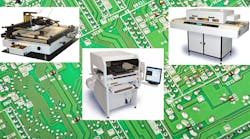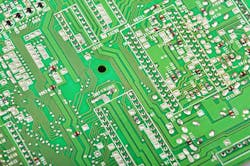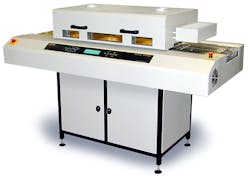This article is part of the TechXchange: PCB Tools and Technology.
What you’ll learn:
- The reasons why it’s best, or perhaps not a good idea, to bring your PCB/SMT assembly in-house.
- How to select the PCB/SMT equipment you’ll need to get started—stencil printer, pick-and-place machine, and reflow oven.
Many OEMs, large and small, rely on offshore vendors for the printed circuit boards (PCBs) vital to their products’ functionality. The ability of those vendors to deliver has been severely affected by the supply-chain issues triggered by the COVID-19 pandemic. Now, political unrest around the globe is exacerbating the situation. These factors are causing a chain reaction of delays that could take years to unravel.
As a result, board (Fig. 1) and material deliveries are taking much longer than usual, and when they do arrive, the costs are much higher. Reshoring and onshoring can help manufacturers solve their product delivery dilemmas to some extent.
But to gain total control over chip production and availability, many are considering bringing their PCB assembly in-house. The types of businesses who stand to benefit from doing this include:
- Low-volume OEMs whose board deliveries have stalled and whose bottom line depends on getting product into the hands of their customers.
- Larger firms looking to reshore some of their outsourced boards for quick-turn or emergency orders.
- Manufacturing firms requiring PCBs for new product prototypes.
Evaluating In-House PCB Assembly Return on Investment (ROI)
In-house PCB assembly is starting to look attractive for many reasons. Minimums are rising for outsourced boards, prices are spiking, and lead times are getting longer. Reducing supply-chain reliance and regaining control of delivery and cost makes good economic sense.
Before you commit to an in-house PCB assembly facility, here are some questions to consider:
- What type of boards do you plan to make in-house?
- What’s the volume and complexity of the boards you will be making (i.e., will skilled labor be needed to run the equipment)?
- Are the needed materials (boards, components, solder, etc.) readily available?
The answers to these questions will determine the total cost of ownership (TCO), which involves factors such as inventory costs, cost on a per-board basis, quantity of boards, and freight issues. They also will help in selecting the right PCB assembly equipment.
Choosing the Best Equipment for Your Needs
You’ll need three different types of machines to get started: a stencil printer, a pick-and-place system, and a reflow oven. Below are descriptions of each machine, what each can do, and how to go about selection based on your needs.
Selecting A Stencil Printer
The first step in a paste-place-reflow assembly operation is the stencil printer (Fig. 2), which can be manual, semi-automatic, or automatic. It dispenses solder paste using a squeegee and forces the paste over openings in a stencil onto a PCB.
The first question to answer is: What is the production range? This will help to decide the level of automation needed:
- Up to 150 boards/day indicates a manual system.
- Up to 500 boards/day is in the semi-automatic range.
- Over 500 boards/day requires a fully automatic stencil printer.
Manual systems
With these systems, speed typically isn’t an issue. Fine pitch and accuracy are the most important factors. Accuracy is determined by how securely aligned the circuit board is in the machine. To ensure this, a good stencil printer should have four adjustment dimensions available: X, Y, Z, and Θ.
Once the board is aligned, paste is applied with a squeegee. Most assemblers use a manual squeegee. Some machines have a built-in guide that aids in applying the right amount of solder paste.
Semi-automatic systems
In moderately high-volume environments, several functions can be automated to some extent, making the process more efficient and allowing for a higher yield at lower cost. The following features are typically found in semi-automatic stencil printers:
- Auto open/close for loading and unloading boards.
- Control of squeegee pressure.
- Control of the squeegee’s movement and speed.
- Visual alignment/assist options to simplify positioning.
Fully automatic systems
With these systems, everything is done without operator intervention. Systems may include automatic board loading/unloading and auto fiducial alignment for X, Y, Z, and Θ positioning. When running 2,000 boards/day, automation may provide significant benefits in terms of quality yield, reduced labor costs, and more control over the process.
Choosing A Pick-and-Place Machine
A pick-and-place machine (Fig. 3) is the second step in a paste, place, reflow assembly operation. The “place” function follows the “solder paste” function in the printer. The “place” operation selects and delivers a component over the board and drops it into position.
The simplest form of pick-and-place operation is by hand—manually picking a component from a bin and positioning it on the board with the aid of tweezers and a magnifying glass. The operation is completed with a handheld soldering iron.
This method can be tedious and time-consuming; it’s best suited to making only a couple of boards a day.
For users interested in higher production volumes, pick-and-place systems range from machine-assisted manual systems up to fully automated systems.
Circuit boards vary in size and complexity, so the level of automation needed can be determined by the number of components per hour (CPH) that will be run.
Manual systems
Manual pick-and-place systems are well-suited for small operations that need to increase handheld production volumes incrementally while improving quality, thus reducing rework and rejects. These systems lead to less operator fatigue, fewer placement errors, and improved yields.
Semi-automatic systems
These systems, more correctly referred to as “enhanced manual” systems, normally include a computer interface with a vision system that shows where the components go. Placement is still done manually. This type of machine helps operators position ultra-fine pitch components more accurately for low-volume applications, an operation difficult to accomplish using a simple machine-assisted manual system.
Automatic pick-and-place systems
These are more common than manual and semi-automatic machines. They have the greatest range of capabilities, including higher placement rates and accuracy, a wider component size range, and the ability to handle larger board sizes.
Determining The Right Reflow Oven
A reflow oven (Fig. 4) liquefies solder in a controlled way to create an electrically conductive bond between the component and board. This can be accomplished in several ways, and not all of them are technically “ovens.”
For instance, the simplest form of heating is performed by conduction, or contact with a heated surface such as a hot plate. Other methods are typically performed within a chamber (oven) using different forms of heat transfer, including convection, infrared, and vapor phase.
Reflow ovens come with up to five heating zones. More zones equate to better flexibility and more control over the profile. The number of zones needed depends primarily on the anticipated throughput; i.e., how many boards processed in a day or a week.
In addition to workflow volume, other considerations for reflow ovens include board size, component density, and appropriate thermal technology.
In a typical low-to mid-volume production scenario, a small, conveyorized, horizontal convection oven meets most basic requirements.
Now for the ROI
You should consult an equipment supplier who can make recommendations for your specific situation and develop pricing to fit your budget. Armed with these facts, you can now do the math.
Does it make sense to bring some or all of your PCB/SMT assembly in-house? This article has covered some guidelines for the equipment, but you’ll also need to consider the following factors:
- Facility space and utilities
- Sourcing materials and components
- Labor and training for operators
- Quality-control instrumentation and staffing
If you still need convincing, consider this: There are U.S.-based equipment makers ready and able to supply customized equipment and excellent customer support.
Less tangible but still important benefits include:
- A more reliable supply chain because products aren’t coming from overseas.
- A smaller carbon footprint because products and materials don’t have to be shipped as far.
- U.S.-made products create more jobs in the U.S.
Balance those considerations with the advantages you may realize, such as faster turnaround plus a potentially higher level of customer satisfaction and loyalty, and it’s a win-win situation all around.
Read more articles in the TechXchange: PCB Tools and Technology.




